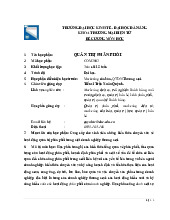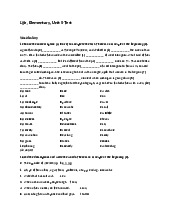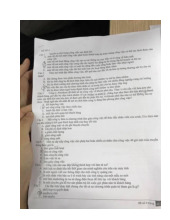



Preview text:
lOMoARcPSD| 49328626
Nội dung 1: Definition of organizing, work specialization? Differences between high and low
work specialization? ( 1 bạn trình bày) Definition:
Organization is the process of blending human and material resources through a formal structure of tasks and
authority; arranging work, dividing tasks among employees, and coordinating them to ensure the
implementation of plans and accomplishment of objectives.
Work Specialization is the degree to which organizational tasks are subdivided into individual jobs; also called division of labor
High work specialization: Is the extent to which jobs in an organization are subdivided into separate
tasks. High work specialization, involving each employee undertaking a very narrow range of
lowdiscretion tasks, is particularly associated with scientific management and Fordism. With too much
specialization, employees are isolated and do only one boring job. In addition, too much specialization
creates separation and hinders the coordination that is essential for organizations to be effective. Low
work specialization: implementing teams and other mechanisms that enhance coordination and
provide a greater challenge for employees.
Nội dung 2: Five Approaches to Structural Design. (2-3 bạn) Đối với từng loại các bạn sẽ nêu
đặc điểm và sự khác biệt giữa những loại này. - Vertical Functional structure
Còn gọi là cấu trúc U (U-form) hay cấu trúc nhất thể - Unitary Structure
Nhóm gộp các vị trí vào các bộ phận trên cơ sở các kỹ năng, năng lực chuyên môn, tính chất công việc, và sử
dụng các nguồn lực tương tự nhau Phân chia bộ phận dựa trên nguồn lực:
Các hoạt động chức năng thể hiện các nguồn lực cụ thể cần thiết để thực hiện các nhiệm vụ của tổ chức Con người,
cơ sở vật chất….cùng sử dụng cho chức năng chung được tập hợp thành bộ phận riêng biệt —Small grouping of
positions into departments on the basis of facilities, expertise, nature of work, and use of similar resources
— IT Separate departments based on resources:
—Operational functions can implement source tools that may be needed to carry out the organization's missions
—Humans, basic materials… .used together for common functions are combined into separate parts Ưu điểm:
Đạt được hiểu quả kinh tế theo qui mô và sử dụng các nguồn lực có hiệu quả hơn
Đào tạo kỹ năng chuyên sâu
Tạo sự tập trung và chỉ huy thống nhất nhược điểm:
Tạo ra rào cản giữa các bộ phận chức năng
Phản ứng môi trường chậm
Quyết định liên quan đến nhiều bộ phận được dồn cho nhà quản trị cấp cao nên ra quyết định chậm trễ Advantages:
—Achieving economies of scale and using resources more efficiently —Intensive skill training
—Create Concentration and Unified Command disadvangtages
—Creating barriers between functional parts
—Slow environmental response
—Decisions involving many departments are left to senior management, so decision making is delayed - Divisional design.
Còn gọi là cấu trúc M (Multi divisional)- Cấu trúc đa bộ phận lOMoARcPSD| 49328626
Các bộ phận trong tổ chức được hình thành dựa trên nhóm gộp con người dựa trên trách nhiệm về cùng một: Sản
phẩm/nhóm sản phẩm/dịch vụ, Chương trình (dự án), Lĩnh vực kinh doanh …Trong mỗi đơn vị độc lập đều có
các bộ phận chức năng, người đứng đầu của mỗi đơn vị chịu trách nhiệm toàn bộ hoạt động của các chức năng.Phù
hợp khi tập đoàn lớn có nhiều dòng sản phẩm cho các thị trường khác nhau vì mỗi đơn vị là một đơn vị kinh doanh tự chủ Ưu điểm:
Linh hoạt và phản ứng theo sự thay đổi
Đáp ứng nhu cầu khách hàng tốt hơn
Chỉ tập trung vào một khu vực địa lý hay tuyến SP
Dễ phối hợp hơn Nhược điểm:
Nhân bản các chi phí và nguồn lực của các đơn vị độc lập
Có thể thiếu chuyên môn hóa ở các đơn vị độc lập
Also called M structure (Multi divisional)- Multi division structure
—Departments in the organization are formed by grouping people based on responsibility for the same:
Product/product/service, Program (project), Business area…In each unit Each independent unit has functional
departments, the head of each unit is responsible for the entire operation of the functions. Suitable when a large
corporation has many product lines for different markets because each unit is an autonomous business unit Advantages:
—Flexible and responsive to change
—Meeting customer needs better
—Focus on only one geographic area or SP line —Easier to coordinate Defect:
—Clone the costs and resources of independent units
—There may be a lack of specialization in independent units - Matrix structure
Kết hợp giữa cấu trúc chức năng và cấu trúc đơn vị
Cải thiện sự phối hợp và thông tin
Tồn tại hai dòng quyền hành ưu điểm:
Có hiệu suất sử dụng nguồn lực cao hơn cơ cấu đơn vị theo chiều dọc hoặc ngang
Linh hoạt thích nghi trước môi trường thay đổi
Sự hợp tác liên bộ phận, chuyên gia sẵn có cho mỗi bộ phận nhược điểm:
Sự phản kháng và thất bại từ chuỗi mệnh lệnh kép
Xung đột cao giữa tuyến chiều dọc và ngang trong ma trận
Quá nhiều cuộc họp, thảo luận hơn hành động
Combination of functional structure and unit structure
Improve coordination and information
There are two lines of authority Advantages:
Have a higher resource efficiency than a vertical or horizontal unit structure
Flexibility to adapt to changing environments
Inter-departmental cooperation, specialists available for each department defect:
Resistance and failure from the double chain of command lOMoARcPSD| 49328626
High conflict between vertical and horizontal routes in the matrix
Too many meetings, more discussion than action - Team-based design.
Đội đa chức năng được tạo lập bởi những người từ các bộ phận chức năng khác nhau để giải quyết một vấn
đề/thực hiện một dự án
Cách tiếp cận theo đội cho phép ủy quyền và chuyển giao trách nhiệm xuống cấp thấp
Linh hoạt và phản ứng nhanh với môi trường và khách hàng
Giúp bổ sung những hạn chế hai loại cấu trúc chức năng và đơn vị
Đội đa chức năng thường sử dụng cho dự án Ưu điểm:
Phá vở rào cản giữa các bộ phận tạo nên sự phối hợp tốt
Các thành viên hiểu rõ những khó khăn của người khác
Đáp ứng tốt nhu cầu của khách hàng và sự thay đổi của môi trường
Ra quyết định nhanh Nhân viên gắn bó với dự án Nhược điểm:
Nhân viên có thể gặp nhiều xung đột và yêu cầu phải trung thành với hai bộ phận Sự phân quyền quá mức
Đặt ra các yêu cầu về công việc khác nhau cho nhân viên hơn so với cơ cấu chức năng
Hội họp nhiều, giảm hiệu quả sản xuất
Ra quyết định có thể chỉ tốt cho đội nhưng không cho tổng thể tổ chức
—A cross-functional team made up of people from different functions to solve a problem/implement a project
—The team approach allows delegation and responsibility transfer down to the bottom
—Flexible and responsive to the environment and customers
—Helps to supplement the limitations of two types of functional and unit structures
—The cross-functional team often used for the project Advantages:
—Breaking the barrier between the parts that create good synergies
—Members understand the difficulties of others
—Meeting well the needs of customers and the change of the environment
—Fast decision making —Staff attached to the project Defect:
—Employees may encounter many conflicts and require allegiance to two departments — Excessive decentralization
—Places different job requirements on employees than does a functional structure
—Many meetings, reduce production efficiency
—Decision making may be good only for the team but not for the organization as a whole - Virtual network.
Mở rộng ý tưởng về sự phối hợp theo chiều ngang và hợp tác
Tổ chức chỉ duy trì một số hoạt động quan trọng được cho là có ưu thế vượt trội so với các tổ chức khác.
Phần lớn các hoạt động còn lại được chuyển giao cho các tổ chức bên ngoài, có thể lan tỏa toàn thế giới
Nền tảng: dựa trên IT, thuê ngoài, liên minh chiến lược
—Expanding the idea of horizontal coordination and cooperation
—An organization that maintains only a few key activities is said to have an edge over others.
—Most of the remaining operations are transferred to external organizations, which can spread around the world
—Platform: IT-based, outsourced, strategic alliance
Nội dung 3: Definition of span of management? Tell me the differences between wide and narrow
span of management (1 bạn trình bày) lOMoARcPSD| 49328626
-The span of management is the number of employees reporting to a supervisor. Some times called
the span of control, this characteristic of structure determines how closely a supervisor can monitor subordinates
Narrow span of control is more expensive as compared to wide span of control as there are more
number of superiors and therefore there are greater communication problems between various levels of management.
A wide span of control is less expensive because the business employs fewer managers. With only
one manager, or a manager with a supervisor or team leader in the hierarchy below, most employees
are all on the same level and can work with each other with clear delegation of duties.
Nội dung 4: Definition, characteristics of authority and power? Differences between them? (1 bạn trình bày)
Authority: Appraisal of the official and legal authority of the administrator in the decision work, additional
resources to achieve the desired results of the organization.
vAuthority is vested in organizational positions, not people
vAuthority flows down the vertical hierarchy vAuthority is accepted by subordinates
Power is defined as the ability or potential of an individual to influence others and control their actions.
Authority is the legal and formal right to give orders and commands, and take decisions.
The power lies in the person, in essence, a person acquires it, but authority lies in the designation,
whoever gets the designation, gets the authority attached to it.




